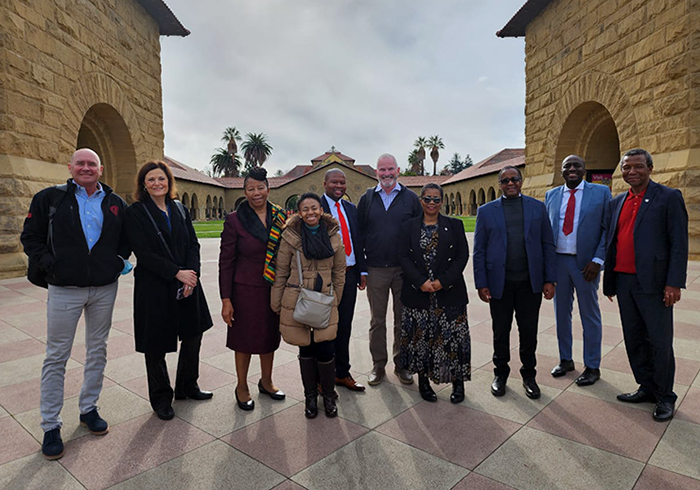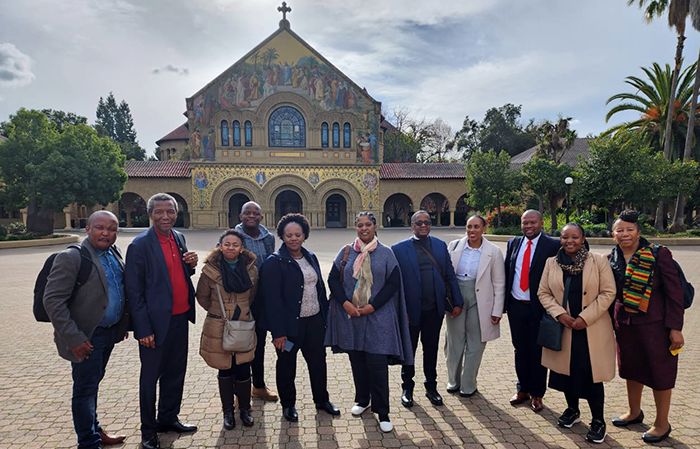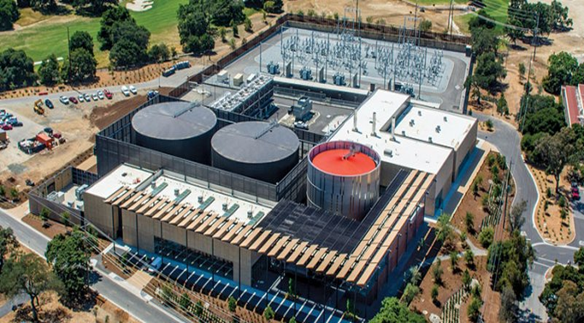
After spending two-and-a-half days of fruitful engagements at the University of California, Los Angeles (UCLA), the Unisa delegation headed to San Francisco to continue its mission of exploration and strategic engagements at Stanford University.

Unisa Principal and Vice-Chancellor, Prof Puleng LenkaBula (fourth from right) and the Unisa delegation with Stanford University hosts Robert Reidy, Vice-President for Land, Buildings and Real Estate (left), Jean Snider, Associate Vice-President for Land, Buildings and Real Estate (second from left) and Jack Cleary, Associate Vice-President for Land, Buildings and Real Estate (on Prof LenkaBula’s left)
Day one of the visit on 08 December saw Unisa’s management team meeting with Stanford University’s Land, Building and Real Estate senior management The Unisa team comprised Professor Puleng LenkaBula, Matsiababa Motebele, Mathabo Nakene-Mginqi, Professor Bhekie Mamba, Professor Madipoane Masenya, Ngwaná Mphahlele, Professor Ramagoai Magano and Feresane Sibeko. Stanford University was represented by Vice-Presidents Robert Reidy, Jack Cleary and Jean Snider.
The main aim of the meeting was to discuss smart campus initiatives. From the warm welcome by the three Stanford managers, through strategic forward-looking engagements and discussions, it became clear to the members of the delegation that the team was once more at the right place and headed for a treat in the sessions that would follow on the two-day visit.
From the three sessions that followed on day one at Stanford University, including a walkabout to view science laboratories and an energy facility, the team gained a great deal of knowledge on Stanford university’s transportation, sustainability and energy facilities.

A scenic stop on the Unisa delegation’s tour of Stanford University’s campus
On Stanford transportation
Stanford University encourages public transportation usage by charging premium prices for parking. In order to discourage the use of cars to campus by members of the Stanford community, the following incentives are provided:
Mr Brian shared some insights into the transportation systems and integration with the public systems. The university has a very comprehensive transport system. In fact, it owns a train station and has a highly commercialised parking system which also serves the public.
The ParkMobile app replaces physical pay stations and as the license plates are smaller in size, making it challenging for the cameras to read, currently there are no Licence Plate Readers (LPRs). The permit system uses a single sign-on and a cardinal key to avoid always authenticating.
On sustainability and energy facilities
Stanford facilities support its Integrated Controls & Analytics Programme (iCAP), which unifies the diverse campus building operations networks and platforms under a single enterprise system.
iCAP has four technical cornerstones:
The analytics allows the university to identify consumption trends at building and campus levels. It also shows the heatmaps that provide fault summary pages.
During the delegation’s meeting with Gerry Hamilton, Stanford Director of Facilities Energy Management, interesting insights were gained on smart campus and efficient energy management. Hamilton shared lessons from the Stanford flagship project under Stanford Energy Sustainability Innovation.
As already hinted, the team went on a walkabout to the recently completed power plant which has transformed the campus-wide energy system. The plant is replacing a 100% fossil-fuel-based combined heat and power plant with grid-sourced electricity. The plant is the first of its kind in terms of the heat recovery system.
This comprehensive Stanford Energy System Innovation (SESI) system will eliminate 150,000 tons of carbon dioxide emissions annually, the equivalent of removing 32,000 cars from the road every year. Expected energy savings to Stanford over 35 years is $425 million.

Stanford University’s remarkable Central Energy Facility
Some of the commercial enterprises that have succeeded in the two universities visited by the delegation (UCLA and Stanford) started as a means of solving a problem within the university or providing a solution to an existing challenge in society through smarter and more efficient strategies. Such solutions that were implemented within the context of solving a university problem then attracted buy-ins from typical prospective end-users and benefactors. For example, the Central Energy Facility at Stanford University is able to tremendously reduce the carbon footprint at university by 80%, a remarkable achievement indeed!
* Packaged by the Department of Institutional Advancement
Read also:
Continuing explorations and strategic conversations at UCLA: Unisa’s delegation hard at work
Publish date: 2022-12-11 00:00:00.0